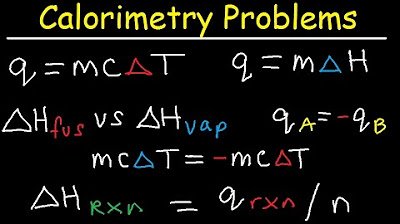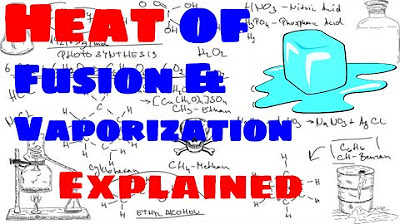Specific heat, heat of fusion and vaporization example | Chemistry | Khan Academy
TLDRThis educational video script explains the heat energy required for phase changes of water. Starting with ice at -10°C, it details the temperature rise and phase transitions to water vapor at 110°C. Key concepts include melting and boiling points, heat of fusion (333 J/g), heat of vaporization (2257 J/g), and specific heat capacities for ice, liquid water, and water vapor. The script calculates the total energy to change 200 grams of ice to vapor, emphasizing the practicality of these values in everyday scenarios.
Takeaways
- 🌡️ The script discusses the phase changes of water and the importance of temperature differences, rather than absolute temperatures, when dealing with Celsius or Kelvin scales.
- 🧊 Starting at -10°C, the temperature of ice increases with added heat until reaching the melting point at 0°C, where heat energy is used to break the ice lattice structure instead of raising the temperature further.
- 🔥 At 0°C, the phase transition from ice to water occurs, and additional heat is used to increase the temperature of the water until reaching the boiling point at 100°C.
- 💧 The heat of fusion is the energy required to change 100g of water from solid to liquid state, which is 333.5 joules per gram.
- 🌫️ The heat of vaporization is the energy required to change 100g of water from liquid to vapor state, which is 2257 joules per gram.
- ⏱️ Specific heat capacities are different for each state of water: 2.05 J/g·K for ice, 4.18 J/g·K for liquid water, and 1.89 J/g·K for water vapor.
- ♨️ The process of warming up ice by 10°C requires calculating the heat using the specific heat of ice, mass, and temperature change.
- 🧊💧 The heat of fusion is applied to calculate the energy needed to melt ice at 0°C into water at the same temperature.
- 💧🔥 The specific heat of water is used to determine the energy required to heat water from 0°C to 100°C.
- 🌪️ The specific heat of vapor is used to calculate the energy needed to increase the temperature of water vapor from 100°C to 110°C.
- 🔢 The total energy required to change 200 grams of ice at -10°C to vapor at 110°C is calculated by summing the energy for each phase change and temperature increase, resulting in 609,950 joules or 609 kilojoules.
Q & A
Why can we use Celsius to measure temperature changes during phase transitions?
-We can use Celsius because the scale is uniform, meaning that one degree in Celsius represents the same temperature change as one degree in Kelvin. This makes it suitable for measuring differences in temperature, which is what matters during phase changes.
What happens to the temperature of ice as it is heated up to zero degrees Celsius?
-As ice is heated, the temperature increases until it reaches zero degrees Celsius. At this point, the added heat energy is used to break the ice lattice structure and add potential energy to the ice, rather than increasing its temperature further.
What is the significance of zero degrees Celsius in the context of water's phase changes?
-Zero degrees Celsius is the melting point of water. At this temperature, ice can turn into water and vice versa, depending on whether heat is being added or removed.
Why does the temperature of water remain constant at 100 degrees Celsius during boiling?
-At 100 degrees Celsius, the added heat energy is used to increase the potential energy of the water molecules, forcing them apart to form vapor. This energy is not used to increase the temperature, which is why it remains constant during boiling.
What is the heat of fusion and how is it related to the phase change of water?
-The heat of fusion is the amount of heat required to change 100 grams of water from its solid state (ice) to its liquid state at 0 degrees Celsius. It is also the energy needed to melt the ice or to freeze the water, with a value of 333 joules per gram.
What is the heat of vaporization and how does it differ from the heat of fusion?
-The heat of vaporization is the amount of heat required to change 100 grams of liquid water at 100 degrees Celsius into 100 degrees Celsius water vapor. It is different from the heat of fusion as it pertains to the transition from liquid to gas, with a value of 2257 joules per gram.
What is specific heat and why is it important for understanding temperature changes in substances?
-Specific heat is the amount of heat energy required to raise the temperature of one gram of a substance by one degree Celsius (or Kelvin). It is important because it quantifies how much energy is needed to change the temperature of a substance, which is crucial for understanding thermal processes.
How much energy is required to warm up 200 grams of ice by 10 degrees Celsius?
-To warm up 200 grams of ice by 10 degrees Celsius, it requires 4100 joules, calculated using the specific heat of ice (2.05 joules per gram Kelvin) multiplied by the mass (200 grams) and the temperature change (10 degrees).
What is the total amount of energy required to change 200 grams of ice at -10 degrees Celsius to 110 degrees Celsius water vapor?
-The total amount of energy required for this process is 609,950 joules, which includes warming the ice, melting it, heating the water to 100 degrees Celsius, vaporizing it, and then heating the vapor to 110 degrees Celsius.
Why is it important to consider the phase of water when calculating energy requirements for temperature changes?
-It is important because different phases of water have different specific heats and require different amounts of energy for phase changes (fusion and vaporization). This affects the total energy needed to achieve a specific temperature change.
How does the specific heat of water in its liquid state compare to that in its solid and vapor states?
-The specific heat of water in its liquid state is about double that of its solid state, at approximately 4.18 joules per gram Celsius. In contrast, the specific heat of water vapor is more similar to that of the solid state, at 1.89 joules per gram Kelvin.
Outlines
🧊 Phase Changes and Energy Requirements of Water
This paragraph discusses the process of heating ice from -10°C to its melting point at 0°C, where the added heat energy is used to break the ice lattice structure rather than increasing temperature. It explains the concepts of heat of fusion (333 joules per gram) and heat of vaporization (2257 joules per gram), which are specific energy amounts required for phase changes. The specific heat capacities for ice, liquid water, and water vapor are also introduced, highlighting the energy needed to raise their temperature by one degree Celsius or Kelvin.
🔢 Calculating Energy for Heating Ice to Vapor
The second paragraph focuses on calculating the exact amount of heat energy required to transform 200 grams of ice at -10°C to vapor at 110°C. It details the step-by-step process, starting with warming the ice to 0°C (4100 joules), melting the ice to water (67,110 joules), heating the water to 100°C (83,560 joules), and finally converting 100°C water to vapor (451,400 joules). The specific heat values for each state of water are used to determine the energy for temperature increases, and the total energy for the entire process is calculated, revealing the substantial amount of heat required for these phase changes.
🔄 Final Steps and Total Energy Calculation
The final paragraph wraps up the energy calculation by addressing the conversion of 100°C vapor to 110°C vapor, which requires an additional 3,780 joules. The narrator acknowledges a mistake in the sequence of calculations but corrects it by including the energy needed to vaporize the water. The total energy required to heat 200 grams of ice from -10°C to 110°C vapor is summed up to be 609,950 joules, or 609 kilojoules. The paragraph concludes by contextualizing this energy amount, comparing it to the heat one might use on a stove to warm half a pound of ice.
Mindmap
Keywords
💡Phase Changes
💡Temperature
💡Heat Energy
💡Melting Point
💡Boiling Point
💡Heat of Fusion
💡Heat of Vaporization
💡Specific Heat
💡Potential Energy
💡Vaporization
💡Joules
Highlights
The video discusses the phase changes of water and the specific heat values for different states of water.
Celsius and Kelvin are interchangeable for phase changes due to their equal temperature differences.
Heat energy is used to break the ice lattice structure at the melting point, rather than increasing temperature.
At zero degrees, both ice and water can exist, and heat is required for phase transition.
Boiling point of water is another phase change where heat energy adds potential energy rather than temperature increase.
Heat of fusion is the energy required to change water from solid to liquid state, measured at 333 joules per gram.
Heat of vaporization is the energy needed to turn liquid water into vapor, at 2257 joules per gram.
Specific heat values are different for solid, liquid, and vapor states of water, impacting energy required for temperature change.
A calculation example is provided to determine the energy required to heat ice to vapor.
The process involves heating ice, melting it, warming water, and vaporizing and further heating the vapor.
The specific heat of ice is 2.05 joules per gram Kelvin, used to calculate warming from -10°C to 0°C.
Heat of fusion is used to calculate the energy to melt 200 grams of ice at 0°C.
The specific heat of liquid water is approximately 4.18 joules per gram Celsius for warming to 100°C.
Heat of vaporization is used to calculate the energy to turn 100°C water into vapor.
The specific heat of vapor is 1.89 joules per gram Kelvin, used for heating vapor from 100°C to 110°C.
A total energy calculation sums up the energy for each phase change and temperature increase.
The total energy required to heat 200 grams of ice from -10°C to 110°C vapor is 609,950 joules or 609 kilojoules.
The video concludes by emphasizing the practicality of understanding energy requirements for phase changes.
Transcripts
Browse More Related Video

Calorimetry Problems, Thermochemistry Practice, Specific Heat Capacity, Enthalpy Fusion, Chemistry

Latent Heat of Fusion and Vaporization, Specific Heat Capacity & Calorimetry - Physics

Chilling water problem | States of matter and intermolecular forces | Chemistry | Khan Academy

Heat of Fusion and Heat of Vaporization Explained

How Much Thermal Energy Is Required To Heat Ice Into Steam - Heating Curve Chemistry Problems

Phase Changes, Heats of Fusion and Vaporization, and Phase Diagrams
5.0 / 5 (0 votes)
Thanks for rating: